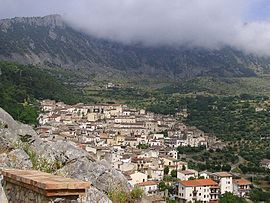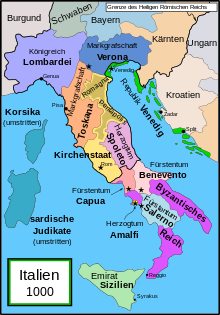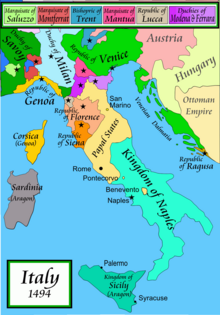Civita
| Civita | ||
|---|---|---|

|
|
|
| Country | Italy | |
| region | Calabria | |
| province | Cosenza (CS) | |
| Coordinates | 39 ° 50 ′ N , 16 ° 19 ′ E | |
| height | 450 m slm | |
| surface | 27 km² | |
| Residents | 872 (Dec. 31, 2019) | |
| Population density | 32 inhabitants / km² | |
| Post Code | 87010 | |
| prefix | 0981 | |
| ISTAT number | 078041 | |
| Popular name | Civitesi (Albanian Çiftiotë ) | |
| Patron saint | San Biagio | |
| Website | Civita | |
 Panorama of Civita |
||
Civita (in Arbëresh , IPA : [ ar'bəreʃ ] : Çifti ) is a mountain community founded by Arbëresh ( IPA : [ar'bəreʃ] ) with 915 inhabitants (as of December 31, 2019) in the province of Cosenza in Calabria in southern Italy . With a view of the Ionian Sea , it is the “gate” of the Pollino National Park for visitors from Apulia , Calabria and Sicily .
Civita was included in the list of the Bandiera Arancione and has been part of the I borghi più belli d'Italia (The Most Beautiful Places in Italy) association since 2003 .
Civita consists of three districts, the historical part of San Antonio (in Arbëresh: Sinandoni ), that of Piazza and that of Magazeno.
geography
The area of the municipality lies on a high plateau at an altitude of 450 m above sea level, surrounded by wooded mountains with a view of the nature reserve Le Gole del Raganello , a narrow gorge of the Torrentes Raganello and covers an area of 27 km² . The Ionian Sea can be seen on the horizon.
Civita is about 75 km north of Cosenza and about 11 km east of Ejanina , a fraction of Frascineto that was founded by Albanian refugees ( Arbëresh ) in the 15th century. Other neighboring communities are Cassano allo Ionio , Castrovillari , Cerchiara di Calabria , Francavilla Marittima and San Lorenzo Bellizzi .
According to the Italian classification for seismic activity , Civita was assigned to zone 2 (on a scale from 1 to 4).
The origin of the name
It is unclear whether the place name comes from çifti , which in Arbëresh "couple" (referring to the two districts of St. Antonio and Magazeno), from çifti , "eagle", or from the Latin civitas .
Based on the morphology of the place, the correct name would be "Adlerhorst" because the place is hidden by the rocks from the sight of the raiding Saracens ; an eagle's view of the Ionian Sea.
history
prehistory
After the Albanian prince Gjergj Kastrioti, called Skanderbeg , had defended Albania against the invading Muslim Ottomans (Turks) for 25 years , he probably died in Lezha in 1468 of malaria . For years Albanian “kapedan” (brave people without a real leader) tried to defend Albania against the Ottomans. The Ottomans finally succeeded in 1478 with the conquest of Kruja and 1479 with that of Shkodra , to bring Albania under their yoke for the next 400 years.

In order to escape the Ottoman yoke, Skanderbeg's widow Donika Arianiti expressed the wish to King Ferdinand I of Naples with her son Gjon Kastrioti II , the only descendant of Skanderbeg, to be allowed to settle on the fiefs of Skanderbeg in the Kingdom of Naples in order to obey the Ottoman yoke escaped, which the king with his letter of February 24, 1468 accepted with "joy".
This was followed by the fourth of eight waves of emigration from Albanian families to Italy . The reasons for this were the geographical proximity and the good relationships between the Kastrioti and the kings of Naples from the House of Aragon .
The Albanians were accepted into southern Italy because, on the one hand, they were considered martyrs of the Christian religion who fought against the Ottomans for decades and thus slowed down the Ottoman invasion of Italy and, on the other hand, because of famine, epidemics and earthquakes (such as the catastrophic of December 5, 1456 ) had depopulated the southern Italian regions, which enabled the landlords to offer the refugees advantageous privileges such as tax halving and full administrative autonomy.
The Albanians in Italy ( Arbëresh ) founded nearly 100 soldiers and farmers colonies, most of which are in Calabria.
The creation of Civita
The historic center of Civita San Antonio was founded in 1471 on an already existing settlement "Castrum Sancti Salvatoris".
Calabria belonged to the Byzantine Empire from the 6th to the 11th century and the coastal towns were repeatedly plundered and plundered by Saracens from the emirate of Sicily .
The ancient site of “Castrum Sancti Salvatoris” was used by Cassanesi and people from the Ionian coast after an attack by the Sicilian Saracens and then burned down by the Saracens in 1014. In 1456 the site was destroyed by an earthquake and abandoned.
In the 11th century Calabria was conquered by the Normans . From 1130 it was part of the Kingdom of Sicily under Roger II, along with other southern Italian regions . At the end of the 13th century, the southern Italian mainland fell under the rule of the French Anjou and formed the Kingdom of Naples . In the middle of the 15th century, the kingdom fell under the control of the Aragonese Crown .
Geronimo Sanseverino (2nd Prince of Bisignano , 4th Duke of San Marco , 6th Count of Tricarico and Chiaromonte , 3rd Count of Altomonte ) favored the settlement of Albanians on his depopulated land. He gave them the opportunity to colonize abandoned sites and found new ones.
When Geronimo Sanseverino was executed in 1487 at the instigation of King Ferdinand I of Aragon for leading part in the failed conspiracy of the barons (1485-1486) against the king in 1487 and the Casale (Italian name for a house or a group of houses in the country) and Fiefs of Civita were confiscated, the generous Greek Count Giorgio Paleologo Assan, who had lived in Galatina with his wife Anna Ralena since 1463 , was commissioned to “bring back what the Albanians who live in his casale in Civita had from some [ People] had been taken from Cassano and Castrovillari , plundered and stolen goods ”.
In a document from 1487 Giorgio Paleologo Assan is described as "a generous lord of great merits for doing the work of the reconciliation of the kingdom", for which King Ferdinand I granted him the Casale of Civita.
King Charles VIII of France , who had a distant right of inheritance to the throne of Naples, went with his armies to Italy and began the so-called Italian wars of the 16th century. Taking advantage of the flight of the Spanish king of Naples Ferdinand II , Charles VIII was able to take Naples and was crowned King of Naples on February 22, 1495 as Charles IV. During his short tenure (- 6 luglio 1495) he set the previous situation of the feudal lords again and gave Berardino (or Bernardino) Sanseverino († 1516?), Son of Geronimo Sanseverino his fief. Thus he was 3rd Prince of Bisignano, 5th Duke of San Marco, 8th Count of Tricarico and Chiaromonte, 4th Count of Altomonte.
In 1539, following the third wedding of Pietroantonio Sanseverino (grandson of Geronimo Sanseverino and son of Bernardino Sanseverino) with Erina Castriota , great-granddaughter of Skanderbeg, more Albanians from Apulia came to Civita, with whom the place reached the number of 276 inhabitants.
In 1572 Bernardino Sanseverino sold Civita to a Baron Campilongo and in 1613 Civita went to Baron Francesco Maria d'Urso. In 1657 the Casale Civita was part of the Duchy of the Serra von Cassano family.
In the centuries that followed, the Kingdom of Naples came under the control of the Habsburgs and Bourbons . During the Napoleonic period (1806-1816) Civita was after the French order of 1807 Università (in southern Italy from 1266 to 1807 name for a more or less independent administrative unit) of Cassano all'Ionio .
Civita today
Today the Albanian language of the ancestors is still spoken fluently in Civita and its inhabitants belong to the Albanian ethnic and linguistic minority of Italy, which is protected by Law 482 “For the Protection of Historical Language Minorities” of December 15, 1999.
Civita was one of the first Arbëresh communities to set up the “Sportello Linguistico Comunale” (communal linguistic counter) provided for by Law 482/99 for the protection and development of the ethnolinguistic heritage.
religion
The eastern character is clearly reflected in the churches of Civita, which belong to the Italo-Albanian Church in the Eparchy Lungro in the ecclesiastical region of Calabria and are immediately , ie directly subordinate to the Holy See .
The Madonna del Rosario (Rosary Madonna) and San Biaggio are the patron saints of Civita and are celebrated with a mass according to the Greek-Byzantine rite .
The mother church of Santa Maria Assunta
In the mother church of Santa Maria Assunta, Arbëresh have been holding the Greco-Byzantine divine liturgy for more than 500 years and keep the impressive Christian Eastern symbolism, the ancient acts and songs of the Greek tradition and, above all, the Albanian language with Greco-Byzantine paraments , icons , Mosaics and iconostasis .
The church of Santa Maria Assunta was built in the early decades of the 17th century according to the regulations of the religious authorities without iconostasis and is located on the present square. A notarial act dated August 25, 1641 shows that Mrs. Costanza Martina Camodeca had the Mary of the Rosary Chapel built in the church of Civita, which means that in 1641 the construction of the church was either completed or nearing completion. At first it was called the New Church because the believers held their cult in the numerous chapels in the historic town center of San Antonio before it was completed. The chapels of San Salvatore, San Leone, of the Holy Spirit, San Francesco and San Pietro no longer exist today. The chapels of San Antonio and Santa Maria della Consolazione are still in the historic district of San Antonio.
According to the Byzantine architecture, the church is not oriented in the main direction east-west with the altar in the east and the entrance in the west, but in the minor direction north-west-southeast with the altar in the north-west. In the Byzantine tradition, the apse is always towards the east, where the sun rises, symbolizing the kingdom of light that represents the Lord God.
The church of Santa Maria Assunta has undergone several renovations over time, with 27 tombs found under the floor. In 1988, at the behest of Papa Antonio Trupo, the Latin altar was replaced with the Greek altar and the iconostasis in olive and walnut wood, typical for churches with the Greek-Byzantine rite.
the “great staircase” with a mosaic of the Last Judgment
The chapel of Santa Maria della Consolazione
According to the plaque next to the entrance door, the chapel is from the 16th century, belonged to the "Basta" family and was managed by the "Lo Passo Caterina and Daughter" family. A date with a Latin dedication was engraved on the chapel bell: “AD 1701 SM CONSOLAZIONE ORA PRONOBIS CATERINA CAVASSA FECIT PRO SUE DEVOTIONE”.
Above the altar is a Madonna and Child on canvas with a wooden frame and a second painting depicting Saint Anne.
In 2006 the chapel was renovated. Today it is owned by the parish.
Attractions
- On the Tuesday after Easter, the Vallet tradition (folkloric representation of one's own linguistic and cultural identity) renews Giorgio Castriota Skanderbeg's victory over the Ottomans
- In the first three days of May, bonfires ( kaminet ) are lit in the various districts and vjershë (traditional arbëresh songs) are spontaneously sung for the occasion .
Magazeno district
- Belvedere " La Culletta " (in Arbëresh: Djepeza )
- Ponte del Diavolo (Devil's Bridge)
- Gole del Raganello (Raganello Gorge), a nature reserve
- The fortress of Kruja above the Raganello Gorge, a reproduction of the fortress of Kruja in Albania from 2000, today's convention center. Inside you can visit the art gallery, which houses paintings by Civita and the Arbëresh ethnic group.
- Church of Santa Maria Assunta (in Arbëresh: Klisha Shën Mëris Fletjes ), Italo-Albanian church with Greek-Byzantine rite
- Ethnic Arbëresh Museum
San Antonio district
- the seven Kodra houses, anthropomorphic houses
- 43 different chimneys, symbols of the social family status, in the districts of San Antonio and Magazeno
- The chapels of San Antonio and Santa Maria della Consolazione
photos
Georg Castrioti Skanderbeg , Albanian national hero
See also
- Settlement areas of the Arbëresh in Italy
- Arabs or Saracens in Sicily
- History of Calabria
- I borghi più belli d'Italia
- Bandiera Arancione
literature
- Vincenzo Bruno, Antonio Trupo: La chiesa di Santa Maria Assunta , III edizione, Rubinetto print, Soveria Mannelli (Catanzaro), 2011
Web links
- Information at comuni-italiani.it (ital.)
- Proloco Civita (Italian), accessed October 9, 2016
- Civita in: Consorzio di Tutela e Vallorizzazione dell'olio extra vergine di oliva DOP Bruzio (Italian), accessed on October 5, 2016
- Civita in: Die Arbëresh in Italy (Italian), accessed on October 5, 2016
- Photo of a Kodra house , accessed October 22, 2016
- The location of the Civita chimneys , accessed October 22, 2016
- List of Italian locations by earthquake zone ( XLS ), from the Italian Civil Defense website (updated March 2015)
- Seismic activity in Italy , accessed October 4, 2016
- List of historical earthquakes from 217 BC Until 2002
Individual evidence
- ↑ Statistiche demografiche ISTAT. Monthly population statistics of the Istituto Nazionale di Statistica , as of December 31 of 2019.
- ↑ Bandiera Arancione. In: Bandierearancioni.it. Retrieved September 20, 2017 (Italian).
- ↑ I borghi più belli d'Italia (official website), accessed on May 12, 2017 (Italian)
- ↑ www.parks.it , see also Italian Wikipedia
- ^ Seismic classification of the municipality of Civita , accessed on October 4, 2016
- ↑ Ordinanza PCM n.3274 of 03/20/2003
- ↑ General Seismic Classification for Italy , accessed January 19, 2017
- ↑ Francesco Trinchera: Codice Aragonese , vol. 1, Arnaldo Forni Editore, Naples 1866, pp. 44 ff., Accessed on October 25, 2016
- ↑ December 5, 1456: The earthquake with magnitude 7.1 that killed 30,000 people (Italian), accessed on February 19, 2017
- ↑ Margherita Forte and Alessandra Petruzza, collaborators at the information desk of Vena, a faction of Maida, Le origini della minoranza linguistica albanese (The Origins of the Albanian-Speaking Minority), 2005, accessed October 6, 2016
- ^ History of Civita (Italian), accessed July 2, 2018
- ↑ Civita, comunità di minoranza linguistica arbëreshe ( Memento of the original from October 9, 2016 in the Internet Archive ) Info: The archive link was inserted automatically and has not yet been checked. Please check the original and archive link according to the instructions and then remove this notice. (Italian, English), accessed on October 9, 2016
- ↑ Demetrio Emmanuele: Itinerari arbëreshë (The routes of the Arbëresh), staff. Tip. Editoriale C. Biondi, Cosenza, 1980, pp. 5 ff., Accessed on October 10, 2016
- ↑ Uomini illustri civitesi , official website of the Civita municipality, accessed October 10
- ↑ Biobibliografia di Civitesi from: Civita, cultura e natura by Demetrio Emmanuele, Print Design, Castrovillari, 2007; accessed on October 10, 2016
- ↑ Demetrio Emmanuele, p. 6
- ↑ Legge 15 December 1999, n. 482, Norme in materia di tutela delle minoranze linguistiche storiche (German: Regulations on the Protection of Historical Language Minorities), accessed on October 20, 2016
- ↑ Vincenzo Bruno, Antonio Trupo, p. 5
- ↑ Vincenzo Bruno, Antonio Trupo, p. 7
- ^ Appellative of the priests of the Greek Orthodox Church and the Eastern United Dioceses of the Italo-Albanian Church in southern Italy and Sicily. Source: Treccani online , accessed October 22, 2016
- ↑ The Vallet of Civita on YouTube , accessed April 22, 2017
Remarks
-
↑ "... Item perche ad nui per loro misso proprio haveno notificato che vorriano venire in quisto nostro regno pregandoce li volesscmo provedcie de alcuno navilio per possere passare: pertanto da nostra parte li esponente che loro venuta ad nui sera multo piacere, et da nui haveranno quelle carize et honori che figlio deve fare ad matre et patre ad figliolo et non solamente li lassaremo quello ce havemo donato, ma quando bisognio fosse li donaremo de li altri nostri boni
Dat. in civitate capue the xxim mensis februarii Anno Domini Mcccclxviii Rex ferdinandus ... " - ↑ ..munifico Giorgio Paleologo Assan RECUPERI ciò che gli è stato tolto since certi di Cassano e di Castrovillari, che hanno depredato e tolto mercanzie agli albanesi dimoranti nel suo Casale di Civita .
- ↑ Signore munifico dai grandi meriti per aver svolto opera di pacificazione del Regno.
- ↑ Date of his will.
- ↑ He was also lord of Castrovillari and Eboli (1496) and Count of Mileto (1507).


















